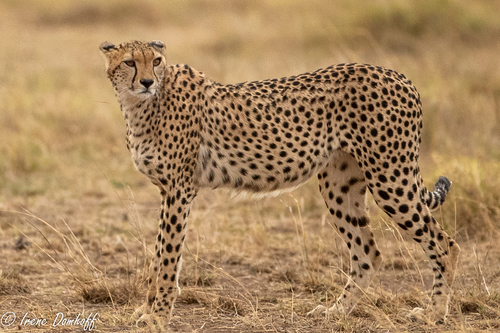
Cheetah
The cheetah (Acinonyx jubatus) is the fastest land animal, famous for its speed and agility. With distinctive 'tear stripes' and a slender build, it thrives on African savannas. Known for its unique chirping calls and inability to roar, it plays a crucial role in its ecosystem.
10-12 years
Lifespan
40.0 - 65.0 kg
Weight
Height: 1.15 - 1.36 m
Size
Brown, Yellow, Black, Tan
Color
20-24 months
Age of Sexual Maturity
3 months
Age of Weaning
70 mph
Top Speed
Vulnerable
Conservation Status
Decreasing
Population Trend
Characteristics
The cheetah, known scientifically as Acinonyx jubatus, is renowned for being the fastest land animal, reaching speeds up to 60-70 mph. It inhabits savannas and grasslands in Africa. Its slender body, long legs, and distinctive black 'tear stripes' running from the eyes to the mouth aid in reducing glare during high-speed chases. Unlike other big cats, cheetahs cannot roar but can purr and make chirping sounds. They rely on their exceptional speed for hunting, typically targeting small to medium-sized ungulates. Cheetahs play a vital role in controlling prey populations, contributing to the ecological balance of their habitats.
Distribution Range of the Cheetah
The Acinonyx jubatus, commonly known as the cheetah, is native to the African continent. Its geographical distribution primarily includes countries in sub-Saharan Africa such as Namibia, Botswana, South Africa, and Kenya. Historically, cheetahs were also found in parts of the Middle East and India, but their range has significantly diminished in these areas.
Cheetah's Habitat
Environmental Conditions
Cheetahs typically inhabit dry, open savannas and grasslands where visibility is high, allowing them to use their speed for hunting. These environments often have a hot, arid climate with sparse vegetation, which suits the cheetah's needs for open space and prey availability.
Ecological Niche
As a carnivorous predator, the cheetah occupies the ecological niche of a high-speed hunter, preying primarily on medium-sized ungulates such as gazelles and impalas. Its adaptations for speed, such as a lightweight frame and large nasal passages, enable it to effectively pursue and capture agile prey in open habitats.
Copyright @ Nature Style Limited. All Rights Reserved.
 English
English